Monday 1 September 1941
 |
| "A yellow star of David marked with the German word for Jew (Jude) worn by Fritz Glueckstein. —US Holocaust Memorial Museum, courtesy of Fritz Gluckstein." |
1 September 1941 marks the two-year anniversary of the invasion of Poland that most people consider the start of World War II. It is not an anniversary that gets much notice, but at such milestones, it is good to briefly summarize events to date.
To this point, the German war effort has been remarkably successful. Against many predictions and their own fears, the Wehrmacht generals stormed across most of western Europe with remarkable ease. As of this date, the Germans and their allies even have made inroads into Africa and Asia with greatly varying degrees of success. The war at sea has been moderately successful for the Germans due to the expanding U-boat fleet, but the Kriegsmarine's weakness in surface ships has been confirmed by some embarrassing losses such as the battleship Bismarck in May 1941 and the cruiser Admiral Graf Spee in 1939. There is no doubt that the British and Americans control the seas, while the air war is a draw with only a very slight edge to the Luftwaffe so far despite its vastly superior numbers in the West. The recently restarted Finnish war effort has been outstanding in accomplishing Finnish war objectives, though those have not always been the same as overall Axis objectives.
There are some quibbles with this seemingly perfect picture. Great Britain has suffered privations, but its military remains completely intact. The British Army has defeated the Italians everywhere and is proving extremely troublesome for the Afrika Korps. The Luftwaffe offensive against Britain failed utterly due to the Royal Air Force, though it has caused tremendous misery. The advance into the Soviet Union continues to progress and many still expect the Germans to win, but the Soviets are fighting much harder than anyone expected. Several German generals, such as OKH Chief of Staff Franz Halder, already have drawn the correct conclusions from this unexpected defense. However, there is nothing that the generals can do about it because Hitler's war aims are limitless and unyielding.
The collapse of the Italian war effort is probably the most significant drawback to the German war effort of the first two years of war. Other than at sea, the Italians have contributed at most some tangential support to the war effort and have had to be bailed out in Greece and North Africa. While not completely unexpected, the Italian military failures have forced the Wehrmacht to divide its focus when otherwise it might have been able to mount a more focused and successful attack on the U.S.S.R. The Germans have been forced to defend Italian possessions that serve no useful purpose, while the Italians contribute little beyond the defense of their own area.
 |
| Soviet soldier teaching civilians how to disarm an un-exploded German incendiary bomb, Sverdlov Square, Moscow, 1 Sep 1941 (Russian International News Agency). |
Unknown to the Germans, the Italians already have made some tentative peace overtures through the Vatican, but they have gone nowhere. Hitler's own half-hearted peace overtures to the British have been completely ignored, and the situation in France remains tense. The French Resistance is just getting started, motivated by terrorist incidents in Paris. In the Balkans, the partisans have occupied large stretches of "conquered" territory, and the Italian occupying forces have proven completely ineffective against them. This has required more German effort to suppress the partisans, a necessity that shows no sign of easing.
The great political imponderables remain the United States and Japan. The US obviously is doing everything short of declaring war that it can to help its British allies, a fact that irks Adolf Hitler but about which he can do nothing. Japan is playing a double game, feigning blind adherence to the German cause and paying lip service to German objectives while secretly trying to resolve its issues with the Americans short of conflict. The Imperial Japanese war effort in China is struggling but is aided somewhat by internal Chinese conflicts between the nationalist and communist forces. There seems little prospect of Japan subduing China, suggesting an endless campaign that never threatens Japan but requires constant supplies and reinforcements.
In sum, the Axis is in control at the two-year mark, although with some serious disappointments. There is a real danger of its forces getting overstretched, and the likeliest sector where that could first become apparent is on the Eastern Front.
 |
| The status of the Eastern Front as of 1 September 1941. |
Eastern Front: The top levels of the German military command increasingly are opposing each other over strategy as resources grow tight. The offensive continues, but it has become impossible to maintain forward momentum in all three army groups at the same time. Choices must be made, and there are tempting major objectives in front of all three fronts.
Regarding the Far North sector, General Halder notes in his war diary that:
[the] Finns have changed their minds and now will continue the drive beyond the national frontiers also on the Karelian Isthmus, but only with limited objectives conformable to their demands for frontier corrections.
Halder later comments on this a little more bluntly, adding that the Finns "do not want to carry the attack beyond their old frontier on the Karelian Isthmus." The Germans, of course, want the Finns to focus on a major objective, Leningrad. Relations with the Finns are still correct, but Marshal Mannerheim already has halted his troops more than once against German wishes.
Finnish troops heading south from Viipuri surround Soviet 43rd and 115th Divisions near Porlammi and Ylä-Somme. About 12,000 Soviet troops melt away through the forest, but the Finns take 9000 prisoners, 55 tanks, 306 artillery guns, and 246 mortars. There also are 7000 Red Army deaths.
In the Army Group North sector, Field Marshal von Leeb tonight proposes an "operational strategy' that OKH Chief of Staff General Halder calls "which is completely out of harmony with our strategy, both in planning and in the direction of the attack." It is easy to read between the lines and presume that von Leeb wants a massive effort north against Leningrad even as the high command is sending troops south to Kyiv. German grand strategy always has been divisive within the top generals, and von Leeb naturally wants the glory of taking Leningrad. However, Hitler views Kyiv as a higher priority.
On the ground, there are heavy rains. There are some local German gains, but, otherwise, it is a quiet day. Panzer Group 4 recaptures Mga, a major rail junction, and continues on toward Lake Ladoga. These gains come at a heavy cost in lives. The Germans come within the artillery range of Leningrad.
In the Army Group Center sector, General Guderian's Panzer Group 2, however, is stalled on its way south from Army Group Center toward Kyiv. Soviet General Timoshenko launches a major counterattack at Gomel which forces Guderian to adopt a defensive posture when he should be attacking south. Other Soviet offensives on the central sector, timed to begin together, also break out east of Smolensk and elsewhere. Soviet 24th Army makes some gains into the German 4th Army line at the lightning-rod position at Yelnya but takes heavy losses.
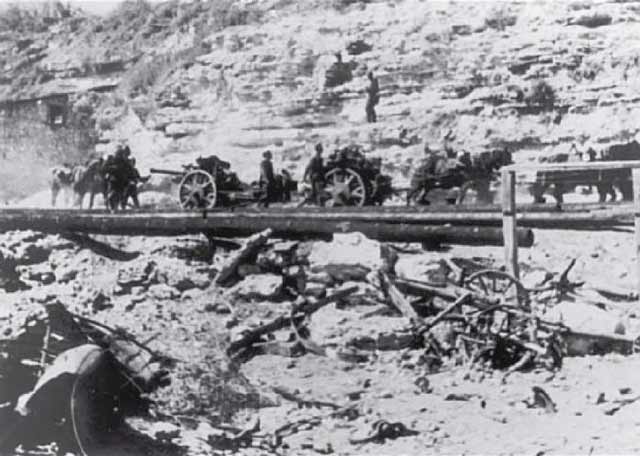 |
| German 30 Corps crosses the Berislav. Shown is a 105mm M18 field howitzer, which was typical divisional artillery. The photo was taken on or about 1 September 1941. National Archives and Records Administration (NARA). |
In the Army Group South sector, Eleventh Army expands its bridgehead over the Berislav River by pouring in five regiments, or about two divisions. In addition, the Germans take another bridge over the Dnepropetrovsk Ridge, a damaged railway bridge, and expand their bridgehead there. Sixth Army, however, reports "severe enemy pressure" on the approaches to Kyiv.
Protecting the crossings at the Dnepr, German fighter group JG 51 claims to have destroyed 77 Soviet bombers.
European Air Operations: The RAF attacks Cologne with 54 bombers (34 Wellingtons and 20 Hampdens) after dark, losing one Hampden. The Germans begin decoy fires which prove effective. The German authorities record damage to only one house, with no casualties.
The British also conduct Roadsted Operations over France, during which they severely damage vorpostenboot V 1512 Unitas 8 at Barfleur, Manche, France.
The RAF also sends four Hampdens to lay mines off Denmark. They return without incident.
A British Overseas Airways (BOAC) Consolidated Liberator Mk. I (serial number AM915) crashes into a hill outside Campbeltown, Argyll, England. All ten people on board perish.
The Luftwaffe sends 25 bombers against Newcastle. This causes extensive damage, destroying over a hundred houses and killing 49 people, with an additional 1000 or so made homeless in the Jesmond and Shildfield areas. Fires are started which blaze for days. A bomb that hits just outside an Anderson shelter kills a man and his two sons while injuring his wife.
The Luftwaffe makes numerous command changes, including installing Oberst Heinrich Conrady in command of KG 3 and Oblt. Georg Pasewald at KG 40.
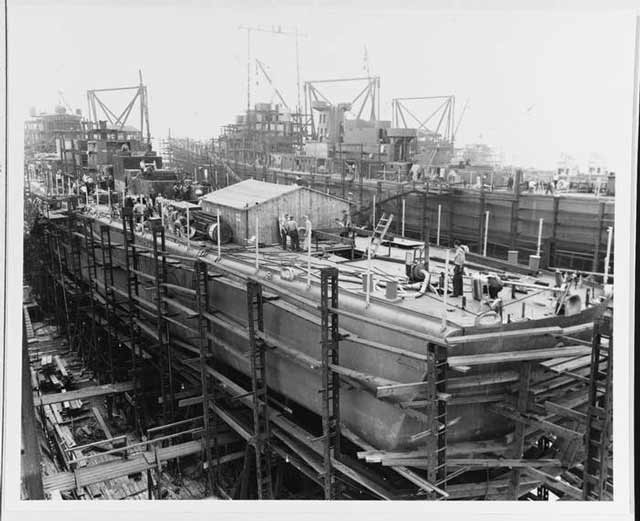 |
| USS Juneau under construction, 1 September 1941. |
Battle of the Baltic: Soviet submarine SC-135 is commissioned.
Battle of the Atlantic: The US Atlantic Fleet under the command of Admiral Ernest J. King forms a Denmark Strait Patrol. This is led by battleships USS Idaho, Mississippi, and New Mexico and two cruisers, Wichita and Tuscaloosa. The announced goal is to protect US shipping. The US Navy permits its ships to escort convoys and escorts ships from Argentia, Newfoundland to Iceland, where the Royal Navy takes over.
Convoy ON-12 departs from Liverpool bound for Reykjavik. Convoy SC-2 departs from St. John, New Brunswick.
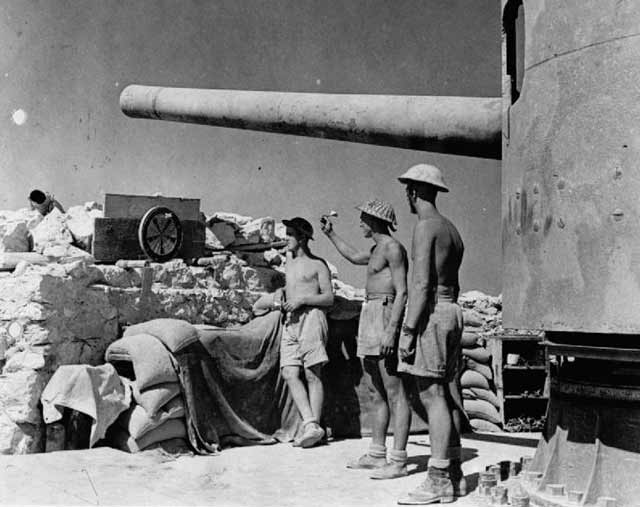 |
| British troops manning a captured Italian 149mm gun relax at Tobruk. |
Battle of the Mediterranean: The Germans activate Panzer Group Afrika. General der Panzertruppe Erwin Rommel is in command while General Crüwell is appointed to replace Rommel at Afrika Korps. Afrika Korps includes 90th Light Division, 15th Panzer Division, and Italian Corps C and XX.
The fifth Vichy French convoy evacuating the Middle East (following the French defeat there) departs from Haifa carrying 5216 French troops. This is all done per the armistice agreement with the British.
An Axis convoy of five merchant ships (Andrea Gritti, Rialto, Vettor Pisani, Francesco Barbaro, and Sabastiano Venier) escorted by four Italian destroyers departs from Naples bound for Tripoli. The RAF based on Malta attacks and sinks 6338-ton Andrea Gritti and damages 6343-ton Francesco Barbaro. Francesco Barbaro returns to Messina, while the remainder of the convoy proceeds to Tripoli.
Royal Navy submarine HMS Otus departs from Malta bound for Alexandria carrying mail, supplies and 15 passengers. The submarine attacks an Italian armed merchant cruiser later in the day but misses.
Royal Navy battleship HMS Queen Elizabeth becomes the flag vessel of the commander of the Mediterranean Fleet. The First Battle Squadron transfers its flag to the Barham.
Malta becomes the base for the Royal Navy's 10th Submarine Flotilla under the command of Commander George W G Simpson.
Battle of the Black Sea: Soviet cruisers Chervona Ukraina and Komintern of the Black Sea Fleet support ground operations by bombarding German and Romanian positions.
Soviet river monitor Zhytomyr runs aground in the Dnepr River at Cherni, remains stuck, and ultimately is lost to scuttling due to the German advance.
 |
| Dallas Morning News editorial writer William Ruggles (pictured above) “thought every American had a right to work." He used those words in an editorial on September 1, 1941. This is the origination of the phrase "right to work." |
Special Operations: The German 61st Infantry Division plans Operation Beowulf, an amphibious invasion of Ösel (also called Saaremaa) and Dagö (also called Hiiumaa). The Soviet 3rd Rifle Brigade defends with 23,700 men. Today, Kriegsmarine cruiser Köln bombards the Soviet coastal batteries located at Cape Ristna, putting them out of action.
The major portion of British Operation Gauntlet begins winding down in Spitsbergen. The Canadians continue destroying coal mines, while troopship HMT Empress of Canada and its escorts arrive back from Arkhangelsk. The Empress carries with it 200 French troops who have escaped from Soviet POW camps. The men of Operation Gauntlet evacuate the island along with about 800 local inhabitants and 15 sled dogs. The Allies have taken no casualties.
Spy Stuff: German Abwehr agent Alphonse Louis Eugene Timmerman arrives in England aboard a ship from Spain. He is quickly arrested.
Partisans: Albanian communist partisans form a united front to oppose the Italian occupiers.
German Resistance: General Halder notes in his war diary a meeting with General Buhle and "Count Stauffenberg." Stauffenberg gives a "cheering" account of his visit to Army Group North. Stauffenberg reports that "the material situation" in the sector is "very good," but a shortage of men is developing. Buhle adds that twelve divisions will have to be disbanded during the winter to make up for losses. Stauffenberg recommends that the soldiers be pulled out of the front to recuperate and make them "in shape for new operations." Stauffenberg's report today has nothing to do with the resistance, but we'll be keeping an eye on him when he pops up at the top levels of the Wehrmacht because of his later resistance activities.
Applied Science: Werner Heisenberg, Germany's top nuclear physicist, discovers how to produce Uranium 94 via a chain reaction. Uranium 94, he theorizes, can be used to make an atomic bomb.
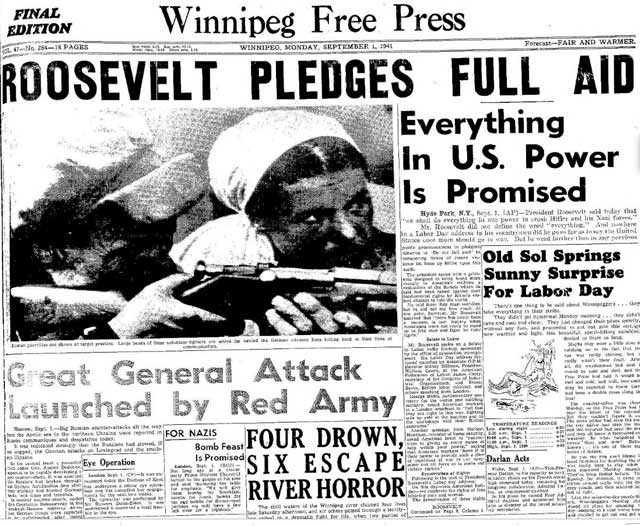 |
| Winnipeg Free Press, 1 September 1941. "Roosevelt Pledges Full Aid." Note that the paper already has news of the Soviet offensive that began on 1 September 1941 in the central sector of the Eastern Front. |
US/Chinese Relations: All of the top U.S. leaders in China - the American Consul-General at Shanghai, the commander of the Yangtze Patrol, and the commanding officer of the 4th Marine Regiment at Shanghai - recommend withdrawing all naval forces in China. This appears to be a result of recent damage sustained from the Japanese bombing.
Japanese/Soviet Relations: The Japanese demand a guarantee of safety for their ships and reparations after a fishing trawler hits a mine off Vladivostok. The Soviets respond to both requests with a firm "No" and tell the Japanese to stay away from their ports.
Anglo/Soviet Relations: The RAF flies Hawker Hurricane fighters of Nos. 81 and 134 Squadrons off of HMS Argus to Vaenga near Murmansk.
Soviet/Estonian Relations: The Soviets execute Estonian military leader Karl Parts. At this time, there is great enthusiasm within some quarters of Estonia at being "liberated" by the Germans.
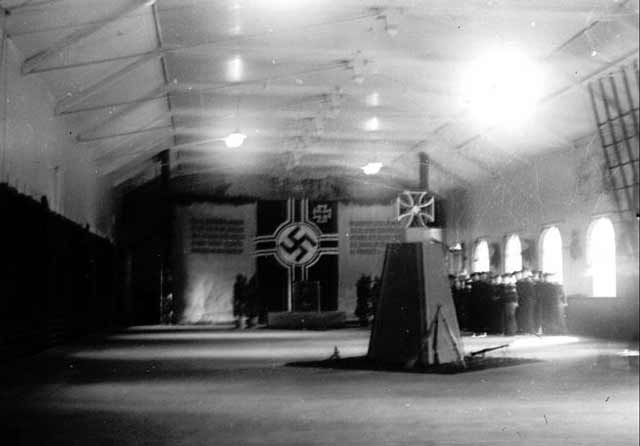 |
| A Wehrmacht ceremony of some kind at Ekserserhuset on Karljohansvern. |
German/ Spanish Relations: Adolf Hitler meets with the commander of the Spanish Blue Division, General Agustín Muñoz Grandes. The division is on its way to the Army Group North sector of the Eastern Front and is marked by its high enthusiasm for the war.
Japanese Military: An attack on Pearl Harbor remains under fierce debate within the Japanese high command. Admiral Isoroku Yamamoto shuts down opposition within his own command and gets his men working on the grand project despite their own doubts:
What you recommended was understandable but I have resolved to carry out the Pearl Harbor attack no matter what the cost. So please do your best to develop the plan from now on. I will place all the details of the project in your hands.
Kusaka proceeds to draw up the plans.
Mineichi Koga becomes commander of the China Area Fleet of the Japanese Navy, while Nobutake Kondo becomes commander of the 2nd Fleet.
Captain Chiaki Matsuda becomes the commanding officer of Settsu.
Soviet Military: The prototype of the Bereznyak-Isayev BI-1 was a Soviet short-range rocket-powered interceptor is readied for gliding tests at Khimki, Moscow Oblast, Russia. Boris N. Kudrin will conduct the flight tests. The aircraft suffers from a lack of rudder and horizontal stabilizer control. The engine being developed by Leonid Dushkin is not yet ready.
General Golikov becomes the commanding officer of the 10th Reserve Army on or about this date.
 |
| General Frank Andrews on the cover of Time magazine, 1 September 1941. |
US Military: The US Army Air Corps places its first production order for 150 Northrop P-61 ("Black Widow") night fighters. The plane has a much better nickname than its performance.
General Marshall makes Walter Bedell Smith the Secretary of the General Staff.
Philippine Army Field Marshal Douglas MacArthur mobilizes the Filipino military. These troops are inducted into US federal service under MacArthur's command. General Marshal resolves to reinforce the Philippines because Hawaii is sufficiently defended.
Australian Military: Major General J. Northcott becomes commander of the 1st Armored Division.
China: The Japanese begin the Second Battle of Changsha by launching attacks across Lake Tun-Ting. Japanese 11th Army takes charge of the battle. Chinese planes attempt to interdict the offensive.
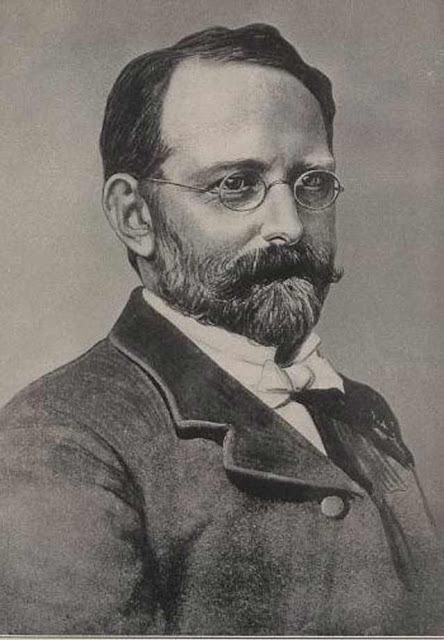 |
| George Pardee, governor of California from 1903-1907, passes away on 1 September 1941. |
Holocaust: German Police Battalion 322 (9th Company) executes about 900 Jews near Minsk. Operating near Vilnius, SS Einsatzgruppen leader Karl Jäger records that his troops executed:
1,404 Jewish children, 1,763 Jews, 1,812 Jewesses, 109 mentally sick people, one German woman who was married to a Jew, and one Russian woman.
Jäger records that local Lithuanians assisted with the executions.
Ther Germans order that beginning on 19 September 1941, all Jews above the age of 6 anywhere under their control must wear a yellow Star of David with the word "Jude" inscribed in black.
French Homefront: An Air France Bloch 220, registration number F-AQNL, has engine failure and crashes into a lake while taking off at Bollermont. There are two survivors and 15 deaths.
Ukrainian Ulas Samchuk, the editor of newspaper Vollnyn, writes in an editorial that Jews and Poles “must disappear completely from our cities.”
The German euthanasia program officially ends, a rare case of Adolf Hitler bowing to public pressure. However, it continues in the camps without much notice by the outside world or the German public.
Alfons Bentele, a veteran of the Dachau camp, takes command of the Majdanek concentration camp.
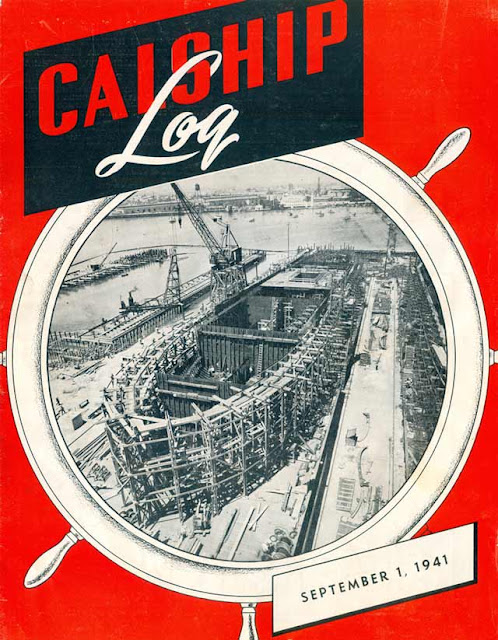 |
| The first bi-monthly issue of CalShip Log, September 1, 1941. |
American Homefront: Television station KYW-TV, located in Philadelphia, begins operation. It is the first television broadcasting station outside of New York City.
It is Labor Day in the United States, and President Franklin Roosevelt gives a radio address. He states in part:
American labor now bears a tremendous responsibility in the winning of this most brutal, most terrible of all wars. In our factories and shops and arsenals, we are building weapons on a scale great in its magnitude. To all the battle fronts of this world, these weapons are being dispatched, by day and by night, over the seas and through the air. And this Nation is now devising and developing new weapons of unprecedented power toward the maintenance of democracy ... Our vast effort, and the unity of purpose that inspires that effort are due solely to our recognition of the fact that our fundamental rights - including the rights of labor — are threatened by Hitler's violent attempt to rule the world.
It is quite a warlike speech for a nation supposedly at peace.
 |
| Life Magazine, September 1, 1941 - baseball player Ted Williams. Williams is flirting with hitting .400, an extremely rare feat in baseball. |
August 1941August 1, 1941: More Executions on CreteAugust 2, 1941: Uman Encirclement ClosesAugust 3, 1941: Bishop von Galen Denounces EuthanasiaAugust 4, 1941: Hitler at the FrontAugust 5, 1941: Soviets Surrender at Smolensk August 6, 1941: U-Boats in the ArcticAugust 7, 1941: Soviets Bomb BerlinAugust 8, 1941: Uman Pocket CapturedAugust 9, 1941: Atlantic Conference at Placentia BayAugust 10, 1941: Soviet Bombers Mauled Over BerlinAugust 11, 1941: Rita Hayworth in LifeAugust 12, 1941: Atlantic Charter AnnouncedAugust 13, 1941: The Soybean CarAugust 14, 1941: The Anders Army FormedAugust 15, 1941: Himmler at MinskAugust 16, 1941: Stalin's Order No. 270August 17, 1941: Germans in NovgorodAugust 18, 1941: Lili MarleenAugust 19, 1941: Convoy OG-71 DestructionAugust 20, 1941: Siege of Leningrad BeginsAugust 21, 1941: Stalin EnragedAugust 22, 1941: Germans Take CherkassyAugust 23, 1941: Go to KievAugust 24, 1941: Finns Surround ViipuriAugust 25, 1941: Iran InvadedAugust 26, 1941: The Bridge Over the DesnaAugust 27, 1941: Soviets Evacuate TallinnAugust 28, 1941: Evacuating Soviets SavagedAugust 29, 1941: Finns take ViipuriAugust 30, 1941: Operation AcidAugust 31, 1941: Mannerheim Says NoSeptember 1941September 1, 1941: Two Years InSeptember 2, 1941: Germans Pushed Back at YelnyaSeptember 3, 1941: FDR Refuses to Meet with JapaneseSeptember 4, 1941: Hitler Furious at GuderianSeptember 5, 1941: Germans Evacuate YelnyaSeptember 6, 1941: Japan Prepares for WarSeptember 7, 1941: Hitler Orders Drive on MoscowSeptember 8, 1941: Leningrad Cut OffSeptember 9, 1941: Germans Attack LeningradSeptember 10, 1941: Guderian Busts LooseSeptember 11, 1941: Convoy SC-42 DestructionSeptember 12, 1941: Starve Leningrad!September 13, 1941: Zhukov at LeningradSeptember 14, 1941: Germany's Growing CasualtiesSeptember 15, 1941: Sorge Warns Stalin AgainSeptember 16, 1941: Soviets Encircled at KievSeptember 17, 1941: Iran Conquest CompletedSeptember 18, 1941: Focke-Wulf Fw 190 in ActionSeptember 19, 1941: Germans Take KievSeptember 20, 1941: Death at KievSeptember 21, 1941: Raging Soviet ParanoiaSeptember 22, 1941: Defense of Nickel MinesSeptember 23, 1941: Air Attacks on LeningradSeptember 24, 1941: Japanese Spying IntensifiesSeptember 25, 1941: Manstein at the CrimeaSeptember 26, 1941: Kiev Pocket EliminatedSeptember 27, 1941: Massacre at EišiškėsSeptember 28, 1941: Ted Williams Hits .400September 29, 1941: Babi Yar MassacreSeptember 30, 1941: Operation Typhoon Begins 2020






























